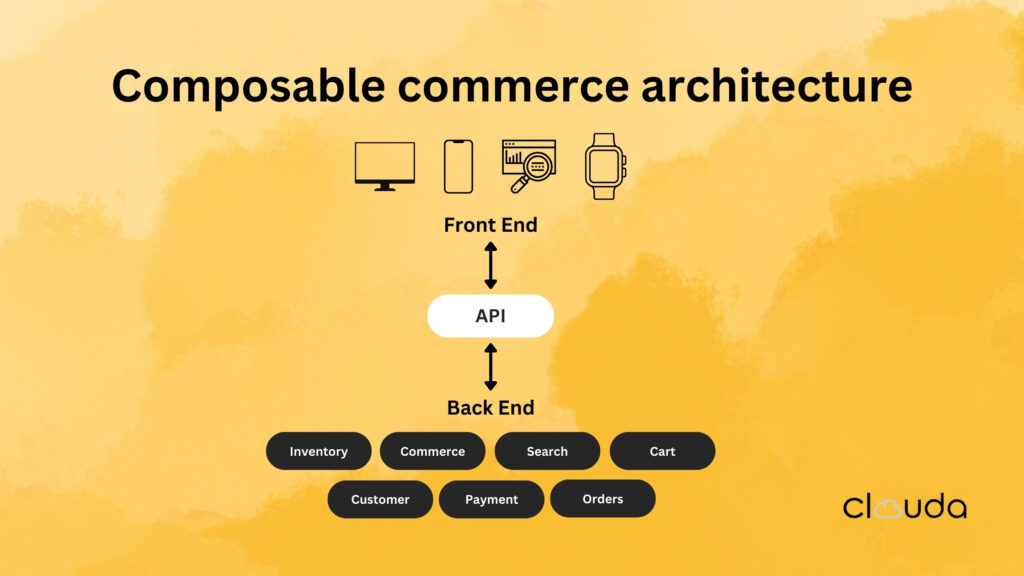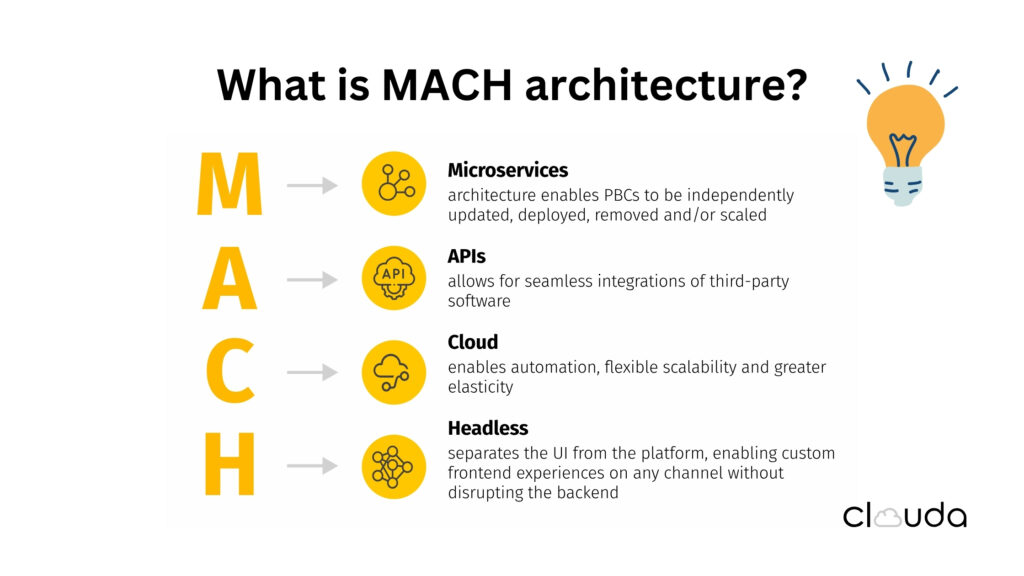Composable Commerce is the next big thing in b2b ecommerce. It’s a new way for organizations to create and customize their businesses with incredible flexibility.
Without using the old approaches, Composable Commerce lets companies build their e-commerce platforms to adjust and grow their online presence. This innovative approach is changing the way we buy and sell online.
In this article we are talking about what is composable commerce, How does Composable Commerce benefit B2B businesses and how we can implement and adopt to the composable commerce approach.
What is Composable commerce?
Composable commerce is a development approach of selecting the best commerce components and combining them into a custom application built for specific business needs.
According to Gartner organizations that adapt to composable approaches will outpace their competitors by 80% in terms of speedy implementation of new features.
Composable commerce allows companies to adapt their online stores quickly to meet specific needs and stay current with trends and customer preferences. Unlike traditional systems, each part of the store is separate, making it easier to make changes or add new features promptly.
Compared to headless commerce, where the front end is separated from the back end, composable commerce offers a more personalized e-commerce system that enables faster innovation and customization.

What is the difference between headless commerce and composable commerce?
Composable commerce is often compared to headless commerce, as both approaches rely on API-driven microservices to create more flexible and customizable e-commerce experiences. However, they have some key differences.
Headless commerce typically involves decoupling the front-end presentation layer from the back-end e-commerce platform, allowing for greater flexibility in designing and delivering digital experiences.
Composable commerce takes this a step further by breaking down the back end of the e-commerce platform into modular, API-driven microservices that can be combined and configured in different ways to create customized e-commerce experiences.
Essentially, composable commerce is a network where every element — not just the front end — functions independently from one another.
What is MACH architecture?

Composable commerce has a strong connection with the principles of MACH architecture.
M- Microservices
A- API-first
C- Cloud-native
H- Headless
Let’s see what it means in each component.
Microservices
Microservices are a way to break an application into independent services by functionality. Packaged Business Capabilities (PBCs) are a set of microservices. By using these tools, this flexibility allows businesses to deploy capabilities independently.
API-first
Composable commerce can make seamless integration of multiple applications By using all functionalities through APIs. This API approach empowers B2B businesses to adopt a composable approach to e-commerce development, connecting various components efficiently.
Cloud-native
With cloud-native infrastructure, businesses can ensure scalability, flexibility, and on-demand access to different parts of the application. By implementing cloud capabilities businesses can eliminate the need for traditional upgrades as well.
Headless
Headless applications, known for their decoupled front-end and back-end services, allow continuous improvement of the customer interface. With headless architecture, businesses can provide their services in different ways and this will improve overall customer experience as well.
How does Composable Commerce benefit B2B businesses?
Scalability
Scalability is one of the primary advantages of adopting composable commerce for B2B businesses. Most of the time Traditional E-commerce systems struggle to handle demands.
In addition to that, composable commerce’s architecture allows companies to scale individual components independently. This means when your business expands, you can add or modify services without affecting the entire system.
When you expand the business, the customer base will also grow according to that. With composable commerce, your platform can meet the demands of this customer base.
Flexibility and Adaptability
With Composable commerce your business can gain better flexibility and adaptability, making it a best choice for B2B enterprises. By decoupling various components of your eCommerce platform, you can replace or upgrade individual elements without affecting the entire system.
With this ability you can easily change according to market changes, customer preferences, and new technologies, ensuring that your business remains competitive in the changing marketplace.
Enhanced Security
Security has become a huge concern for B2B businesses that handle sensitive customer data, transactions, and confidential information. The API-first architecture of Composable commerce, enables strong security measures.
By implementing security protocols at the API level, you can ensure protection against cyber threats more effectively. With This approach, you can monitor the process well reduce the risk of data theft and ensure the safety.
Improved Stability
Any downtime or system failure can have so many consequences for B2B businesses. That’s why Stability is crucial for B2B businesses. Because composable commerce is built on cloud-native principles, it will ensure the stability of the platform.
Cloud-based infrastructure has automatic failover capabilities, so it will reduce the risk of disruptions. Also with the isolation of microservices errors in one component will not impact the entire system, so make sure a stable and reliable eCommerce platform.
Faster Time-to-Market
With the competitiveness of the B2B commerce world, getting products and services to market quickly is really important to be successful.
Composable commerce helps you to do that by enabling quick development and deployment of new features and functions. With this architecture, you can create personalized buyer experiences, and Implement new updates faster so you can be ahead of the competition.
How to adopt composable commerce for B2B
Determine your level of readiness
Before you implement composable commerce in your business, make sure your company is ready for it.
So you can start that by evaluating your company’s current digital maturity, including its technological infrastructure, IT system agility, and operational process flexibility.
After that evaluate the current technical expertise within your team and identify areas that require additional skills, whether through training or recruitment. Knowledge in API management, microservices, and cloud-based solutions is very Important.
Then figure out how composable commerce fits into your company’s future digital strategy. Identify any issues or problems, develop a strategy for developing skills through training, recruitment, and forming partnerships with technology and service providers.
Create a personalized composable commerce solution through planning and design
You can Begin by outlining your business requirements, goals and customizing the composable commerce solution to fit your organization’s needs. For that you need to Identify key components like inventory management, customer service, and payment processing.
Then you can plan how they will work together in the composable framework.
During the design phase, focus on an API-first architecture to make smooth integration and communication between microservices.In this phase you need to Prioritize user experience to make the system user-friendly for customers and internal users.
Then Work with stakeholders from different departments to align with functional needs and overall business objectives. This approach make sure a better strategy for planning and designing your composable commerce solution.
Implementing a composable commerce approach
To successfully adopt composable commerce, consider the following approach:
Begin with a pilot program
When you implement,try to Start small by focusing on specific component.So you can test and learn before expanding.
Seek expertise
Partnering with an experienced expert in composable commerce is crucial for success in your business. Select a platform with the necessary knowledge and infrastructure which you can help in creating the ideal solution for your business.
Emphasize adaptability, protection, and compliance
When you implement , Make sure that your composable commerce system can effortlessly adapt to new modules and growing demand as your business expands.
Additionally, verify that each component and their interconnections work according to industry standards and data protection regulations.
Continuously refine
After deployment, one of the most important things to do is consistently monitor, analyze, and enhance your system. Stay updated on new technologies and market trends to maintain the relevance of your system.
Introducing composable commerce is a strategic move that makes sure B2B organizations improve customer needs and scalability. Businesses can successfully adapt to digital transformation by evaluating their readiness, customizing solutions, and following best practices.
Conclusion
With the evolving nature of B2B commerce businesses need a new way that address the customer needs and adapt to the new market.
In this changing b2b environment, composable commerce rises as a valuable solution, offering businesses a roadmap to navigate through these transformations.
It helps companies with the necessary tools to customize their digital strategies to meet the customer needs that are changing very quickly.
With the flexibility of composable commerce, organizations can optimize their processes, Increase customer satisfaction levels, and maintain a competitive edge in the ever-changing marketplace.
Composable commerce stands out as a practical, cost-efficient, and strategic method for B2B eCommerce, aligning well with the demands of modern markets and customer preferences.

